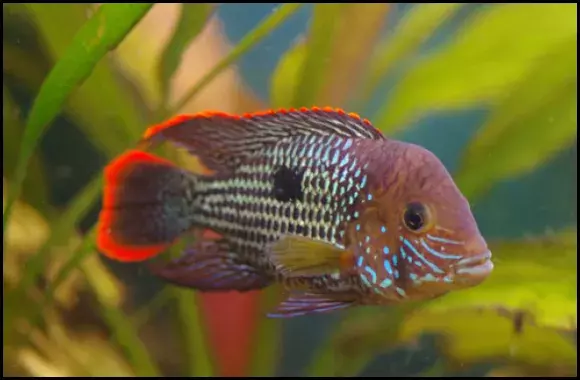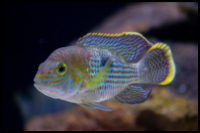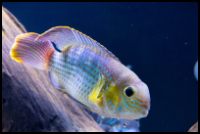





Quick Care Details (Table)
| Livestock Characteristics | Value |
|---|---|
| Care Level | Moderate |
| Temperament | Aggressive |
| Diet | Carnivore |
| Maximum Size | 12 Inches |
| Minimum Tank Size | 55 Gallons |
| Plant Safe | Yes |
| Temperature Range | 72-82°F |
| PH Range | 6.5-7.5 |
| KH Range | 4-8 Degrees |
| GH Range | 4-12 Degrees |
Species Specific Categories
Helpful Video
Care Details
Aquascape
- Provide plenty of hiding spots, caves, and crevices using rocks, driftwood, or artificial structures.
- Incorporate live plants, but be aware that the Green Terrors may uproot or damage them.
Substrate
- Use a fine to medium-sized substrate like sand or small gravel.
- Avoid sharp or rough substrates that may harm the cichlid's delicate fins.
Disease prevention
- Maintain good water quality through regular water changes and proper filtration.
- Quarantine new fish before introducing them to the main tank to prevent the spread of diseases.
Filtration
- Use a powerful and efficient filtration system suitable for the size of the tank.
- Consider a combination of mechanical, biological, and chemical filtration to maintain water quality.
Lighting
- Provide moderate to low lighting levels in the aquarium.
- Avoid overly bright or intense lighting, as it may cause stress or algae overgrowth.
Water Flow
- Green Terrors prefer moderate water flow in the aquarium.
- Ensure proper circulation without generating strong currents that may stress the fish.
Temperament and Behavior
Behavior
- Green Terrors are known for their territorial and aggressive behavior in your tank, especially during procreation and when defending their territory.
- They may exhibit aggressive behavior towards smaller or more docile aquarium fish, especially if the tank is not adequately spacious or if they feel threatened.
Breeding
- Green Terror Cichlids are substrate spawners and form monogamous pairs during procreation.
- They will prepare a spawning site by digging pits in the substrate and guarding the eggs and fry aggressively.
- Breeding success may require providing suitable conditions, including optimal water parameters, proper diet, and ample hiding spots.
Compatibility
- Green Terrors fish are generally not suitable for community tanks due to their territorial and aggressive nature.
- They may be kept with similarly sized and robust cichlid species that can hold their ground or in a species-only setup.
Tank mates
- Choose tank mates that can handle the Green Terror Cichlid's aggression and are similar in size and temperament.
- Some suitable tank mates include other semi-aggressive or robust cichlids like Severums, Firemouth Cichlids, or larger Tetra species.
- Avoid keeping them with small, peaceful fish or fin-nippers.
Activity Level
- Green Terror Cichlids are generally active swimmers, but they may spend a significant amount of time patrolling their territory and defending their spawning sites.
- They appreciate the availability of ample hiding spots and areas to establish their territories.
Clean up Crew
- Green Terrors are not typically considered part of a "clean-up crew."
- While they may consume some small invertebrates or leftover food, they are primarily carnivorous and not efficient cleaners.
- Incorporate other suitable bottom-dwelling scavengers like catfish or snails for effective cleanup.
Diet and Nutrition
Dry Foods
- Green Terrors can be fed high-quality dry foods, such as cichlid pellets or flakes specifically formulated for cichlids.
- Look for pellets or flakes that offer a balanced nutritional profile and are suitable for carnivorous cichlids.
- It's advisable to vary their diet by offering a mix of dry foods to ensure they receive a range of nutrients.
Frozen Foods
- Your Green Terror Cichlid will readily accept frozen foods, which can be an essential part of their diet.
- Offer frozen foods like brine shrimp, bloodworms, daphnia, or mysis shrimp.
- Thaw the frozen food before feeding, rinse it to remove any excess juices, and offer it as a treat.
Live Foods
- Live foods can be a beneficial addition to the diet of the Green Terror, simulating their natural feeding behavior.
- They can be fed live foods like blackworms, small earthworms, or feeder fish (in moderation and from reputable sources).
- Cultivating live foods at home, such as brine shrimp or daphnia, can provide a convenient and nutritious food source.
Vegetables
- While Green Terrors are primarily carnivorous, they can also benefit from some vegetable matter in their diet.
- Offer blanched or steamed vegetables like spinach, zucchini, cucumber, or peas.
- Cut the vegetables into small, manageable pieces and attach them to a weighted food clip to prevent them from floating away.
Algae
- The Green Terror may consume some algae as part of their natural diet.
- However, algae alone may not provide sufficient nutrition for their dietary needs.
- While some algae growth in the tank can be beneficial, supplementing their diet with other food types is necessary.
Tank Parameters
Tank size
- Green Terror fish grow to a size of around 8-10 inches (20-25 centimeters) in length.
- A tank size of at least 55 gallons (200 liters) is recommended for a single Green Terror Cichlid.
- Larger tanks with more swimming space and hiding spots can help reduce aggression and territorial behavior.
Tank Length
- While specific tank length is not as critical as tank volume, a longer tank provides more swimming space for your Green Terror fish.
- Aim for a tank length of 48 inches (120 centimeters) or larger to accommodate their active nature.
Water Temperature
- Green Terror fish are native to tropical regions and prefer warmer freshwater temperatures.
- Maintain the water temperature within the range of 72-82°F (22-28°C).
- Use a reliable aquarium heater and thermometer to ensure stable temperature conditions.
pH (Acidity/Alkalinity)
- Green Terror Cichlids can tolerate a wide pH range, but a slightly acidic to neutral pH is recommended.
- Aim for a pH range of 6.5-7.5.
- Avoid significant fluctuations in pH, as it can stress the fish.
KH (Carbonate Hardness)
- Green Terror fish are adaptable to a range of freshwater hardness levels.
- Aim for a KH range of 4-8 dKH (degrees of Carbonate Hardness)
- Stability in water parameters is more important than hitting specific values.
GH (General Hardness)
- Aim for a GH range of 4-12 dGH (degrees of General Hardness) for Green Terror fish.
- Green Terror Cichlids can tolerate slightly soft to moderately hard water conditions.
- Maintain stability in GH levels as sudden fluctuations can stress the fish.
Hardiness
- It's important to note that even though Green Terror fish may not be the hardiest fish, with proper fish care and attention to their specific needs, they can thrive and live a healthy life in a well-maintained aquarium.
Nitrate (NO3) levels
- Green Terror fish are sensitive to high nitrate levels, which can negatively impact their health.
- Keep nitrate levels below 20 ppm (parts per million) and ideally as close to 0 ppm as possible.
- Regular freshwater changes, proper filtration, and maintaining a balanced aquarium ecosystem help control nitrate levels.
History, Popularity, History and Species Variety Details
The History of the Green Terror Cichlid
Green Terror Cichlids, scientifically known as Andinoacara rivulatus, originate from the rivers and lakes of Ecuador and Peru in South America. They are native to the Amazon River basin and surrounding areas, including the Marañón and Ucayali River systems. This region is known for its rich biodiversity and is home to numerous cichlid species.
The Green Terror was first described by French zoologist Achille Valenciennes in 1860. Initially classified under the genus Acara, it was later reclassified to Andinoacara. The species name "rivulatus" refers to their presence in rivers and streams.
In their natural habitat, Green Terror Cichlids inhabit various freshwater environments. They are found in rivers, streams, lakes, and flooded areas, demonstrating their adaptability to different habitats. These cichlids are known to seek shelter among submerged rocks, tree roots, and vegetation, which provide protection and spawning sites.
Back to topReasons Why These Fish Are Popular
- Vibrant Coloration: One of the primary reasons for the popularity of Green Terrors is their stunning appearance. They exhibit a vibrant green coloration with shimmering scales that make them stand out in any aquarium. The males, in particular, showcase impressive fin extensions and can display additional colors like blue or yellow during procreation.
- Feisty Personality: Green Terror Cichlids are known for their territorial and aggressive behavior, which intrigues many cichlid enthusiasts. Their bold and feisty nature adds an exciting element to aquarium keeping. While this behavior may not make them suitable for every community tank, it attracts aquarists seeking lively and engaging fish.
- Unique Body Shape: Green Terror Cichlids have a unique body shape, with a sleek profile and elongated fins. Males typically have more pronounced dorsal and anal fins, adding to their striking appearance. Their distinct body structure sets them apart from other cichlid species, garnering attention from aquarists looking for something visually distinct.
- Breeding Behavior: Green Terror Cichlids exhibit fascinating breeding behavior, which captivates many hobbyists. They form monogamous pairs and engage in intricate courtship rituals. During spawning, they construct nests, guard the eggs, and actively defend their territory. Witnessing their parental care and territorial behaviors can be a rewarding experience for dedicated aquarists.
- Size and Presence: Green Terror Cichlids are relatively large cichlids, with males reaching sizes of up to 10 inches (25 centimeters). Their size, combined with their vibrant coloration and assertive behavior, makes them a prominent and eye-catching addition to larger aquariums. Their commanding presence and confident demeanor contribute to their popularity.
- Compatibility with Cichlid Enthusiasts: Green Terrors have gained popularity among dedicated cichlid enthusiasts who appreciate their unique characteristics and are knowledgeable about cichlid care. These hobbyists often create species-specific setups or carefully select suitable tankmates to accommodate the Green Terror's territorial tendencies.
Male gender vs Female gender (Sexual Dimorphism)
- Observe Size Differences: In general, male Green Terror Cichlids tend to be larger than females. Males can reach sizes of up to 10 inches (25 centimeters), while females are usually slightly smaller.
- Analyze Body Shape: Males often have a more elongated and streamlined body shape compared to females. They may appear sleeker and more slender.
- Examine Fins: Males typically have more extended and pointed dorsal and anal fins compared to females. These fin extensions can be more pronounced, especially in mature males.
- Observe Coloration: During breeding, males often display more vibrant and intense colors compared to females. They may exhibit additional shades of blue or yellow, especially on their fins and face.
- Look for Ovipositor: In females, a small papilla called the ovipositor can sometimes be seen near the vent. This structure is used for laying eggs and may be more apparent during breeding or when the female is ready to spawn.
- Observe Behavior: Males often display more territorial and aggressive behavior, especially during procreation. They may establish and defend territories more actively compared to females.
- Pairing Behavior: Green Terror Cichlids form monogamous pairs during procreation. Observing the interactions between fish can provide hints about their gender. Males may engage in courtship behaviors, while females may exhibit more protective or nurturing behavior.
Breeding The Green Terror
- Pair Selection: Start by selecting a compatible male and female pair. It's ideal to choose sexually mature individuals that are healthy and in good condition. Introduce them to a separate breeding tank or provide suitable procreation conditions in the main tank.
- Set Up the Breeding Tank: Create a suitable environment for breeding. Use a spacious tank with a capacity of at least 55 gallons (200 liters) to provide ample swimming and breeding space. Include hiding spots, caves, or structures made from rocks, driftwood, or PVC pipes for the pair to establish territories and spawning sites.
- Water Conditions: Ensure the water parameters are within the appropriate range. Aim for a temperature between 75-82°F (24-28°C) and a pH range of 6.5-7.5. Maintain stable water quality and perform regular water changes to ensure optimal conditions for breeding.
- Conditioning and Diet: Prior to breeding, condition the pair by providing a nutritious and varied diet. Offer high-quality pellets, flakes, live or frozen foods like bloodworms, brine shrimp, and small crustaceans. Include vegetable matter such as blanched spinach or cucumber to diversify their diet.
- Trigger Breeding Behavior: Mimic the natural conditions that stimulate breeding. Increase the water temperature slightly and perform partial water changes to simulate the onset of the rainy season. Adjust the lighting to create a natural day-night cycle.
- Courtship and Spawning: During the breeding process, the male will exhibit courtship behaviors to attract the female. He may display vibrant colors, flare fins, and engage in fin movements and quivering motions. The female will respond by showing receptive behavior, and a dance of chase and courtship will follow.
- Spawning Site Preparation: Green Terror Cichlids are substrate spawners. Provide suitable spawning sites such as flat rocks or clean surfaces for the female to lay eggs. The male will accompany the female, guiding her to the chosen spot and fertilizing the eggs.
- Egg Care and Incubation: After spawning, the female will lay adhesive eggs on the chosen substrate. The male will guard and fan the eggs with his fins to provide oxygen and prevent fungus growth. It's crucial to maintain water quality and stability during this period.
- Fry Care: After hatching, the fry will remain attached to the spawning site for a few days. Once they become free-swimming, they can be fed with newly hatched brine shrimp, finely crushed flakes, or specialized fry food. Maintain excellent water conditions and provide appropriate hiding spots and cover for the fry to ensure their survival.
- Parental Care: Both parents may take part in caring for the fry. However, the female may become more protective and aggressive during this period. It's crucial to monitor the interactions and remove any aggressive parent if necessary to prevent harm to the fry.
Frequently Asked Questions
How big do Green Terror Cichlids get?
Green Terror Cichlids can grow to around 8-10 inches (20-25 centimeters) in length, with males typically being larger than females.
Are Green Terror Cichlids aggressive?
Yes, Green Terror Cichlids can exhibit aggressive behavior, especially during breeding and when defending their territory. They may not be suitable for peaceful community tanks.
Can a Green Terror Cichlid be kept with other fish?
Green Terror Cichlids are best kept with similarly sized, robust fish that can handle their aggression. Avoid keeping them with smaller or more docile fish that may become targets.
What should I feed Green Terror Cichlids?
Green Terror Cichlids are omnivorous and can be fed a varied diet. Offer high-quality pellets, flakes, frozen foods like bloodworms and brine shrimp, and occasional vegetable matter.
How do I provide suitable tank conditions for Green Terror Cichlids?
Provide a spacious tank with hiding spots, caves, and ample swimming space. Maintain stable water conditions with a temperature of 75-82°F (24-28°C) and a pH range of 6.5-7.5.
Can a Green Terror be bred in captivity?
Yes, Green Terror Cichlids can be bred in captivity. Create suitable breeding conditions, including a separate breeding tank, proper water parameters, and provide suitable spawning sites and hiding spots.
How can I differentiate between male and female Green Terror?
Males tend to be larger and may have more extended and pointed fins. During breeding, males may display more vibrant colors and patterns. Females may have a smaller size and lack the intense coloring of males.
How long do Green Terror Cichlids live?
With proper care, a Green Terror Cichlid can live for several years. They have an average lifespan of around 8-10 years, but some individuals may live longer with optimal conditions.
Are Green Terror Cichlids suitable for beginners?
Green Terror Cichlids are not recommended for beginners due to their aggressive nature and specific care requirements. They are better suited for experienced cichlid keepers.
Can a Green Terror Cichlid be kept in a planted tank?
A Green Terror Cichlid may uproot or damage live plants due to their digging behavior. It's advisable to select hardy plants or provide suitable tank decorations as an alternative.
How often should I feed a Green Terror?
Your Green Terror Cichlid should be fed 1-2 times a day, with an amount they can consume within a few minutes. It's important not to overfeed to maintain good water quality and prevent obesity.
How can I reduce aggression in a Green Terror?
Providing ample hiding spots, territories, and visual barriers can help reduce aggression among Green Terror Cichlids. Ensuring a spacious tank with appropriate tankmates and proper feeding can also contribute to reducing aggression.
Can a Green Terror Cichlid change their coloration?
A Green Terror Cichlid can exhibit changes in coloration based on their mood, breeding status, or environmental factors. Males, in particular, may display more intense colors during breeding or when excited.
Can a Terror Cichlid jump out of the tank?
A Green Terror Cichlid has the potential to jump out of the tank if they feel stressed or threatened. It's important to provide a secure lid or cover to prevent accidental escapes.
Are Green Terror Cichlids compatible with invertebrates?
The Green Terror Cichlid may view small invertebrates as potential prey and may not be suitable for tanks with delicate or small invertebrates. It's advisable to avoid keeping them together to ensure the safety of the invertebrates.

